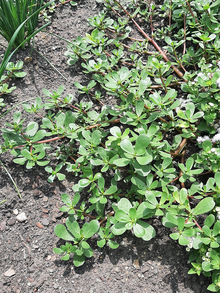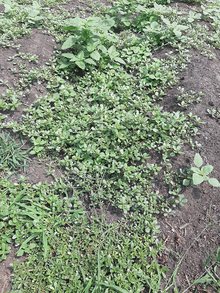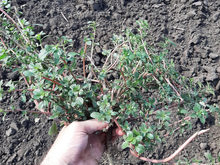By the end of July, I had traveled to several parts of the Midwest. Visiting family in Iowa, helping teach a soils class in St. Paul, then driving up to Alexandria for some farm tours. At each place, I saw the same weedy plant. It had reddish stems and rubbery leaves, creeping along the bare ground—common purslane (Portulaca oleracea).
Widespread purslane
The “common” in the name “common purslane” certainly is descriptive.
Purslane has a worldwide distribution, but is largely considered an introduced weed in Minnesota. There is evidence common purslane was in North America and was used by its people before 1492. This is mostly based on old pollen and seed discoveries in Canada and the U.S.
One colorful theory is that Leif Erikson and his fellow Vikings brought purslane over to North America around 1000 AD. This “Viking hypothesis” is far from agreed on by most scientists, and does not line up with older archaeological findings of common purslane.
Controlling purslane
One reason purslane is so easy to find is because it thrives in bare patches, disturbed areas and drier spots. It only lives for a year, but can spread vegetatively or by seeds. Its flowers are yellow in color, but usually are hard to spot.
Some herbicides can be effective in big infestations, but in smaller areas just pulling out the root system can help. Make sure to get purslane out of the garden when you pull it, in case it has mature seeds.
An organic weed control method, solarization, does not work as well to kill purslane as it does other plants. Solarization is a method where a clear plastic tarp is put over an area to heat up, dry out, and eventually kill weed seedlings. One University of California Davis publication stated that if you manage to control purslane with solarization, probably everything that could go right did go right. Purslane can withstand a lot of temperature and water stress.
Purslane’s drought tactics
All plants eventually need water. Yet some populations of purslane do better in drought than others. In a Virginia State study, African strains of purslane survived up to 60 days with no water, while ones from rainy Great Britain fared much worse. In general, however, common purslane performs well in heat and dryness.
One way purslane is competitive in drought is that it can change how it makes its food from the sun. Normally, it uses what is called C4 photosynthesis. This is the same type corn (Zea mays) uses, and this efficient photosynthesis does really well in warm climates.
About 50% of grass species use C4 photosynthesis, so some will say that all C4 plants are some type of grass. But not purslane. It is in the Portulacaceae (purslane) family, not the Poaceae (grass) family that corn belongs to.
While C4 photosynthesis is very effective during our summers, it is less effective if it gets too dry. During drought, purslane can switch from C4 to CAM photosynthesis. Many cacti use CAM, a type of photosynthesis that gathers carbon dioxide at night when it's cooler and keeps leaves from transpiring during the daytime. This helps keep water vapor from escaping during the sunny hot days. Not surprisingly, many CAM plants reside in desert environments.
Aside from switching its photosynthesis, purslane also has other tricks to stay a step ahead of drought. It can store extra water in its leaves and stems, almost like a rain barrel. As it gets hotter and drier, it uses some of the stored water. When it rains again, the plants squirrel away some for the next dry spell.
Purslane’s root system also is quite impressive, diving deep into the ground. One plant I pulled up in St. Paul had a taproot almost as thick as a small carrot!
Can you eat purslane?
Purslane’s leaves and stems are edible, and have been traditionally consumed in the Middle East and Mediterranean. However, the biggest issue with eating purslane is that it has very high oxalic acid concentrations compared to other vegetables. Too much oxalic acid can cause kidney stones, particularly in certain people.
There is evidence from a French and New Zealand study that pickling or boiling can remove oxalates from purslane. Unfortunately, other studies using their same techniques showed less of an effect.
What does purslane taste like? To me, purslane’s taste seems to change each time I bite into one. The few I munched had some combination of lemony sour, slightly oily, or watery and bland一not quite a ringing endorsement. The changing taste of purslane could be dependent on the weather and time of day, according to Wisconsin Extension.
With one notable exception, garlic mustard, I generally discourage people from eating weeds in your garden. At the very least practice moderation if you choose to do so.
Purslane you find in your raised bed was not bred to be eaten like your broccoli. Plants can be less or more edible depending on chance and how the environment acts on them over time. As such, common purslane is more concerned with its survival during this drought than how it tastes in a salad.
- Byrne, R., & McAndrews, J. H. (1975). Pre-Columbian purslane (Portulaca oleracea L) in the New World. Nature, 253(5494), 726-727.
- Chandran, R. (2020). Common Purslane. University of West Virginia Extension.
- Elmore, C., Stapleton, J., Bell, C., Devay, J. (1997). Soil Solarization: A Nonpesticidal Method for Controlling Diseases, Nematodes, and Weeds. University of California Davis.
- Forseth, I. N. (2010) The Ecology of Photosynthetic Pathways. Nature Education Knowledge 3(10):4
- Gonnella, M., Charfeddine, M., Conversa, G., & Santamaria, P. (2010). Purslane: a review of its potential for health and agricultural aspects. Eur. J. Plant Sci. Biotechnol, 4, 131-136.
- Jin, R., Shi, H., Han, C., Zhong, B., Wang, Q., & Chan, Z. (2015). Physiological changes of purslane (Portulaca oleracea L.) after progressive drought stress and rehydration. Scientia Horticulturae, 194, 215-221.
- Mahr, S. (2021). Common Purslane, Portulaca oleracea. University of Wisconsin Extension.
- Poeydomenge, G. Y., & Savage, G. P. (2007). Oxalate content of raw and cooked purslane. Journal of food agriculture and environment, 5(1), 124.
- Ren, S., Weeda, S., Akande, O., Guo, Y., Rutto, L., & Mebrahtu, T. (2011). Drought tolerance and AFLP-based genetic diversity in purslane (Portulaca oleracea L.). Journal of Biotech Research, 3, 51.
- Sage, R. F. (2004). The evolution of C4 photosynthesis. New phytologist, 161(2), 341-370.




